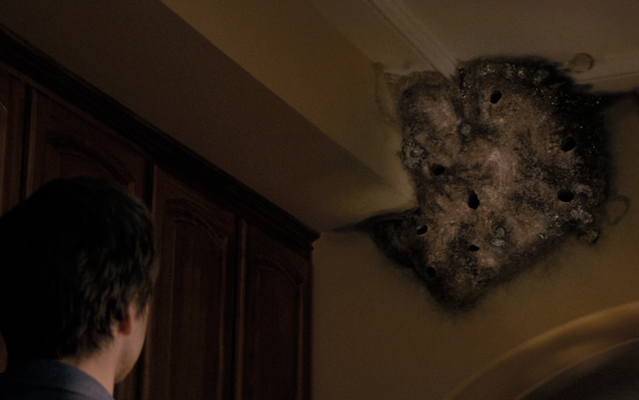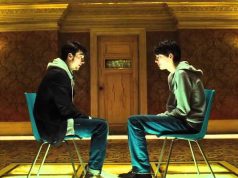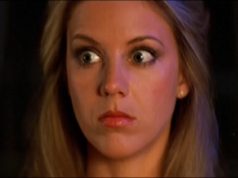
“The Apparition” marks a bold step forward in filmmaking. After decades of stubbornly resisting the influence of lobbyists and special-interest groups, Hollywood has finally made a movie about people who are frightened by strange occurrences in their new home.
At long last! The one remaining taboo in popular cinema has fallen, and audiences can now be thrilled and intrigued by tales of homeowners whose cabinet doors open inexplicably! Yet this news is bittersweet, for now we must contemplate how many compelling stories have been withheld from us all these years due to Hollywood’s reluctance to show families moving into houses and hearing spooky noises therein. So much wasted potential!
As if the central premise of supernatural events taking place in a quiet house weren’t fresh enough, “The Apparition” begins with what appears to be yet another innovative technique: the first few minutes of the movie are in the form of material purported to have been filmed not by an unseen omniscient camera but by the characters themselves, using home movie cameras! This “footage” that someone “found” — let us call it, for lack of a better term, “found footage” — depicts a 1973 semi-scientific effort by quasi-scientists to contact spirits, and it is all the more exciting because some words on the screen tell us the exact date that it happened. I mean, if I tell you that some improbable event took place “in 1973,” you will not believe me. But if I say it happened “on May 21, 1973,” well, now you’re convinced.
After approximately one pointless minute of this, the movie jumps ahead to the present, where a batch of college students are trying to replicate the 1973 experiment. They’re attempting to do what we just saw some other people do. Basically, the movie didn’t want to reference an event that took place at an earlier point in time without showing us footage of that event, lest we become hopelessly confused. “They say they are copying the 1973 experiment — but how do we know what the 1973 experiment looked like??” is what we would have been saying at this juncture. This part is also in the style of “found footage,” to coin a phrase.
Oh, but whoops, this only lasts a minute, too, and then we jump to another location and another set of characters, seemingly unconnected to the previous ones. This is where the movie actually starts, for real this time. Those prologues were just warm-up exercises, like batting practice, or the first season of “Seinfeld.”
Now, in the real movie (shot in the traditional fashion), we’ve got Kelly (Ashley Greene) and Ben (Sebastian Stan), an almost supernaturally bland young couple who have just moved into a new tract home in Palmdale, Calif., an almost supernaturally bland desert community in which nothing interesting has ever transpired. That streak will not be broken today. Kelly and Ben are only in their mid-20s, yet they are boring at an 80-year-old level, speaking stilted dialogue in emotionless voices and generally giving the impression that the actors have been forced at gunpoint to say words they neither mean nor understand.
No sooner have Dull and Duller moved into their cookie-cutter tract home than odd things begin to happen. For example, they find mold growing! And, um, that’s it. So not “things,” I guess. Just one thing, mold. Still, this is alarming because the house is brand-new, and also because we’re 15 minutes into the movie and nothing has happened yet, so any occurrence, even one as mundane as mold, seems exciting. “The Apparition” is a film that asks its audience to be frightened by the presence of fungus.
Things that are more genuinely troubling do start to occur after this, mostly along the lines of objects being moved by invisible forces and scratch marks appearing on walls. (Just imagine if another movie had ever dared employ such devices of terror before!) While Ben vainly reacts to this by installing surveillance cameras — as if ghosts will show up on video!!! — Kelly does the sensible thing and takes a shower. All experts in paranormal activity advise young women to shower when frightened. After this, in further accordance with established protocol, she walks around the house in her underwear for a while, and the movie checks those items off its list.
It only takes 70 or 80 nights of tiresome, repetitive terror for Ben and Kelly to try staying at a motel, but the malevolent force follows them. So it’s not the house. The house is blameless. Quit trying to pin everything on the house. When the neighbors’ dog wanders over, sits on the floor for a minute, then dies — causing the little girl next door to glare reproachfully at Kelly and say with contempt, “Your house killed my dog” — well, the girl is wrong, and she should apologize, both to Kelly and the house.
So what IS the problem? Well, it turns out that the second pointless prologue, the one where they were trying to duplicate the experiment shown in the first pointless prologue, was filmed by Ben. He and his science buddies inadvertently unleashed some kind of evil, and now, a few years later, the evil thing wants to rearrange furniture and kill dogs.
Here’s where the film comes dangerously close to having an interesting idea before veering back into brazenly formulaic nonsense. According to what writer-director Todd Lincoln has said in interviews (and it’s also suggested in the film’s trailer), the original concept was that these supernatural forces only came into being because people believed in them. There is no monster under the bed — but if you believe strongly enough, you can conjure the monster into existence. That’s an intriguing psychological premise. It’s also where Carlos Mencia came from.
But at some point, every trace of that concept was deleted from the movie. Now it’s just a regular ol’ demon or ghost or something. All that’s left of the original idea is a lot of nonsense dialogue about brainwaves and EEGs (“Linking process complete! Amplifying transmitter feed!”), mostly delivered by the guy who ran Ben’s experiment, played by Tom Felton (aka Draco Malfoy), who shows up late in the movie, possibly by accident. His plan to repel the demon, which might have made sense at one point, now just sounds like crazy people putting tinfoil on their heads to keep aliens out.
And it doesn’t work anyway. After an interminable 80 minutes of Ashley Greene and Sebastian Stan emoting vacantly like stoned CW Network actors doing a high school version of “Poltergeist” after suffering head injuries, the movie finally ends with the evil force taking them off to hell, or wherever. No twist, no payoff, no callback — nothing. Some non-scary, non-entertaining crap happened for a while, the end, screw you, thanks for the ten bucks.
I don’t pretend to know what goes on behind studio doors (that’s not true, I do pretend to know), but my assumption here is that the people at Warner Bros. watched the first cut of “The Apparition” and then said, “You know, this is almost as inane, useless, incompetent, and insulting a horror film as we’ve ever released. If we could just lose the one thing about it that’s mildly creative, then we’d have something awful that we could truly be proud of, insofar as we are proud of awful things, like toddlers who smear their poop on the walls.” In fact, I’m certain that’s what the Warner Bros. people said, and you can’t prove they didn’t.
— Film.com





